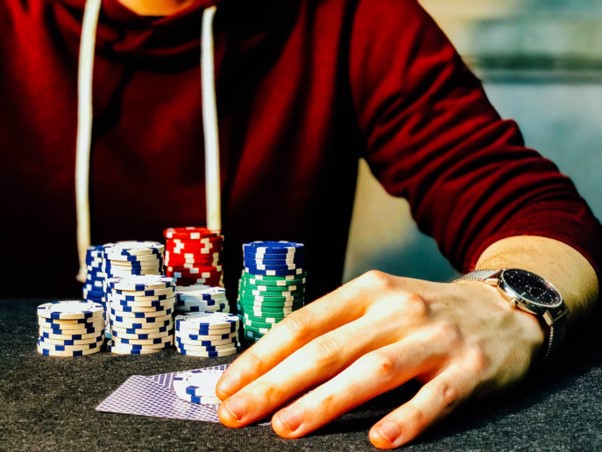






Ace-to-Five Triple Draw: Does It Ever Snow?by Kevin Haney | Published: Nov 01, 2023 |
|
|
 Ace-to-Five Triple Draw Lowball (A-5) is a relatively straightforward poker variant where the best hand is A-2-3-4-5 and neither straights nor flushes count against you. It’s widely considered to be a more simplistic cousin of Deuce-to-Seven Triple Lowball (Deuce or 2-7), but this may not be entirely true.
Ace-to-Five Triple Draw Lowball (A-5) is a relatively straightforward poker variant where the best hand is A-2-3-4-5 and neither straights nor flushes count against you. It’s widely considered to be a more simplistic cousin of Deuce-to-Seven Triple Lowball (Deuce or 2-7), but this may not be entirely true.
One of the main reasons why most believe it to be less complicated is because “snowing” is generally less prevalent in A-5 than it is in Deuce.
Snowing is getting aggressive and staying pat with a busted hand with one or more draws to go in an attempt to get your opponent to fold before showdown.
Since this will eliminate any chance of making a legitimate holding, there is an opportunity cost to making the play. Therefore, whenever we choose to snow, we should feel that turning our hand into a bluff has a higher expectation than continuing to draw. Some factors to consider when making this assessment include the quality of the draw we would be foregoing, the cards we have seen, and of course, our opponent.
In 2-7, an aggressive player may three-bet isolate a late position opener with a hand such as 4-6-7-8, a subpar top-heavy draw that can make a straight. The usual plan is to try and make an eight or nine low on the first draw, and failing that, often attempting to snow the hand through. However, since straights don’t count against you in A-5, that very same opponent may be much less apt to snow with a hand like 3-5-6-7.
However, if you never snowed in A-5 you would be leaving money on the table as the expectation of snowing with bad draws will often exceed that of playing them out in an honest fashion. In addition, having bluffs in your river-betting range will also allow you to get paid off more often with your good hands.
Suppose we open from the button with 3-3-5-6-J and get reraised by the big blind that is holding A-2-3-4. The big blind draws one; we improve to a 3-5-6-7-10, and call our opponent’s flop bet.
In a heads-up pot we should always keep the seven as it will increase our realization of equity, and a seven low will often be good enough to win.
Once again, our opponent takes a single card and we happen to catch a pair of sevens. On the turn our opponent checks, often indicating he’s not yet home. We are then faced with a decision between checking behind and taking the free street, or betting and standing pat with 3-5-6-7-7 as a bluff.
Let’s examine the math of the situation.
At this turn juncture there are 4.25 big bets in the middle. While our opponent doesn’t always have a perfectly smooth draw, his draw is almost always better than ours, usually making him around a 52-55% favorite. The river betting is a relatively neutral situation as we have position, but most often the inferior draw.
Assuming we have 45% equity and there’s nothing gained or lost in the river betting, the expectation of checking the turn is as follows:
EV of Checking and Drawing = (45%)(4.25) = 1.9 big bets
If we decide to turn our hand into a bluff, our opponent will make 7-4-3-2-A, 6-4-3-2-A, or a wheel around 20% of the time and an 8-4-3-2-A with a 10% frequency. Most opposition would (and probably most often should) lead any seven or better since our patting range contains many eight, nine, and ten lows. With 8-4-3-2-A, many might opt to check, and in this example we’ll assume they do check and call the river. Assuming our opponent folds all worse hands (i.e. nines and above), we’ll win the pot around 70% of the time.
Under these set of assumptions, we lose one big bet when our opponent makes a seven or better (we fold to his lead), and two bets the times he catches an eight. When our play works we will win the 4.25 big bets that were in the middle, plus the additional turn bet that we made the villain call. If the hand plays out in this manner, the expectation of turning our hand into a bluff is estimated as:
EV Snowing = (70%)(5.25) + (20%)(-1) + (10%)(-2) = 3.3 big bets
As you can see, turning our hand into a snow beats checking and drawing by approximately 1.4 big bets (3.3 – 1.9), which is quite a fantastic result in a limit game. In this specific case our opponent needs to include both 10-4-3-2-A and 9-4-3-2-A in his check-call range to make us relatively indifferent between checking and snowing.
Now let’s assume that the pot was not reraised before the first draw, thus there are only 3.25 big bets in middle:
EV of Checking and Drawing = (45%)(3.25) = 1.5 big bets
EV Snowing = (70%)(4.25) + (20%)(-1) + (10%)(-2) = 2.6 big bets
Even in the smaller pots, our decision to turn our hand into a bluff may result in an increase in expectation over one big bet. Again, our opponent would have to defend more aggressively, which he is less apt to do when there wasn’t as much action in the hand. Most of your opponents will just give you credit for a real holding, so yes indeed, it should sometimes snow in A-5. ♠
 Kevin Haney is a former actuary but left the corporate job to focus on his passions for poker and fitness. The certified personal trainer owned a gym in New Jersey, but has since moved to Las Vegas. He started playing the game back in 2003, and particularly enjoys taking new players interested in mixed games under his wing and quickly making them proficient in all variants. Learn more or just say hello with an email to [email protected].
Kevin Haney is a former actuary but left the corporate job to focus on his passions for poker and fitness. The certified personal trainer owned a gym in New Jersey, but has since moved to Las Vegas. He started playing the game back in 2003, and particularly enjoys taking new players interested in mixed games under his wing and quickly making them proficient in all variants. Learn more or just say hello with an email to [email protected].
Features
Tournaments
Strategy